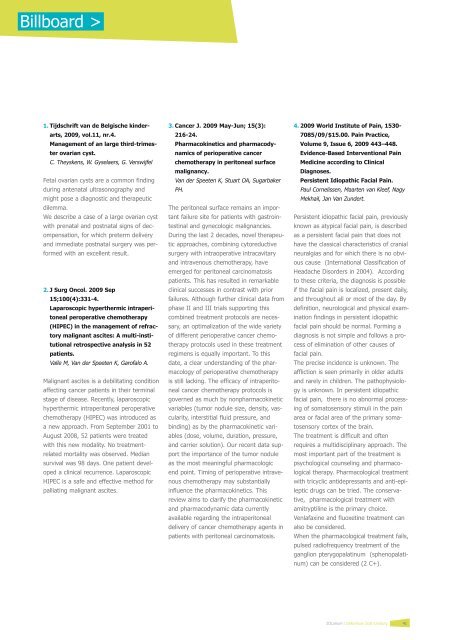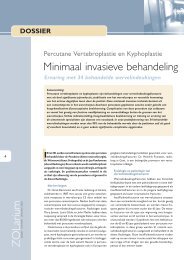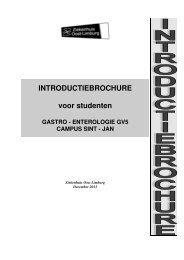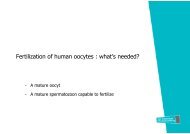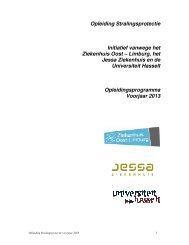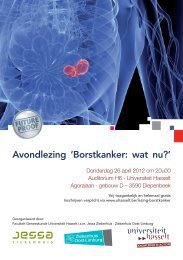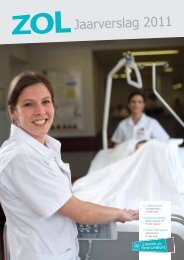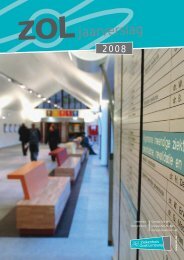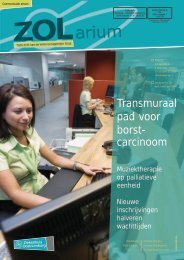Nieuw: SPECT/CT in het ZOL
Nieuw: SPECT/CT in het ZOL
Nieuw: SPECT/CT in het ZOL
You also want an ePaper? Increase the reach of your titles
YUMPU automatically turns print PDFs into web optimized ePapers that Google loves.
Billboard ><br />
1. Tijdschrift van de Belgische k<strong>in</strong>derarts,<br />
2009, vol.11, nr.4.<br />
Management of an large third-trimester<br />
ovarian cyst.<br />
C. Theyskens, W. Gyselaers, G. Verswijfel<br />
Fetal ovarian cysts are a common f<strong>in</strong>d<strong>in</strong>g<br />
dur<strong>in</strong>g antenatal ultrasonography and<br />
might pose a diagnostic and therapeutic<br />
dilemma.<br />
We describe a case of a large ovarian cyst<br />
with prenatal and postnatal signs of decompensation,<br />
for which preterm delivery<br />
and immediate postnatal surgery was performed<br />
with an excellent result.<br />
2. j Surg Oncol. 2009 Sep<br />
15;100(4):331-4.<br />
Laparoscopic hyperthermic <strong>in</strong>traperitoneal<br />
peroperative chemotherapy<br />
(HIPEC) <strong>in</strong> the management of refractory<br />
malignant ascites: a multi-<strong>in</strong>stitutional<br />
retrospective analysis <strong>in</strong> 52<br />
patients.<br />
Valle M, Van der Speeten K, Garofalo A.<br />
Malignant ascites is a debilitat<strong>in</strong>g condition<br />
affect<strong>in</strong>g cancer patients <strong>in</strong> their term<strong>in</strong>al<br />
stage of disease. Recently, laparoscopic<br />
hyperthermic <strong>in</strong>traperitoneal peroperative<br />
chemotherapy (HIPEC) was <strong>in</strong>troduced as<br />
a new approach. From September 2001 to<br />
August 2008, 52 patients were treated<br />
with this new modality. No treatmentrelated<br />
mortality was observed. Median<br />
survival was 98 days. One patient developed<br />
a cl<strong>in</strong>ical recurrence. Laparoscopic<br />
HIPEC is a safe and effective method for<br />
palliat<strong>in</strong>g malignant ascites.<br />
3. Cancer j. 2009 May-jun; 15(3):<br />
216-24.<br />
Pharmacok<strong>in</strong>etics and pharmacodynamics<br />
of perioperative cancer<br />
chemotherapy <strong>in</strong> peritoneal surface<br />
malignancy.<br />
Van der Speeten K, Stuart OA, Sugarbaker<br />
PH.<br />
The peritoneal surface rema<strong>in</strong>s an important<br />
failure site for patients with gastro<strong>in</strong>test<strong>in</strong>al<br />
and gynecologic malignancies.<br />
Dur<strong>in</strong>g the last 2 decades, novel therapeutic<br />
approaches, comb<strong>in</strong><strong>in</strong>g cytoreductive<br />
surgery with <strong>in</strong>traoperative <strong>in</strong>tracavitary<br />
and <strong>in</strong>travenous chemotherapy, have<br />
emerged for peritoneal carc<strong>in</strong>omatosis<br />
patients. This has resulted <strong>in</strong> remarkable<br />
cl<strong>in</strong>ical successes <strong>in</strong> contrast with prior<br />
failures. Although further cl<strong>in</strong>ical data from<br />
phase II and III trials support<strong>in</strong>g this<br />
comb<strong>in</strong>ed treatment protocols are necessary,<br />
an optimalization of the wide variety<br />
of different perioperative cancer chemotherapy<br />
protocols used <strong>in</strong> these treatment<br />
regimens is equally important. To this<br />
date, a clear understand<strong>in</strong>g of the pharmacology<br />
of perioperative chemotherapy<br />
is still lack<strong>in</strong>g. The efficacy of <strong>in</strong>traperitoneal<br />
cancer chemotherapy protocols is<br />
governed as much by nonpharmacok<strong>in</strong>etic<br />
variables (tumor nodule size, density, vascularity,<br />
<strong>in</strong>terstitial fluid pressure, and<br />
b<strong>in</strong>d<strong>in</strong>g) as by the pharmacok<strong>in</strong>etic variables<br />
(dose, volume, duration, pressure,<br />
and carrier solution). Our recent data support<br />
the importance of the tumor nodule<br />
as the most mean<strong>in</strong>gful pharmacologic<br />
end po<strong>in</strong>t. Tim<strong>in</strong>g of perioperative <strong>in</strong>travenous<br />
chemotherapy may substantially<br />
<strong>in</strong>fluence the pharmacok<strong>in</strong>etics. This<br />
review aims to clarify the pharmacok<strong>in</strong>etic<br />
and pharmacodynamic data currently<br />
available regard<strong>in</strong>g the <strong>in</strong>traperitoneal<br />
delivery of cancer chemotherapy agents <strong>in</strong><br />
patients with peritoneal carc<strong>in</strong>omatosis.<br />
4. 2009 World Institute of Pa<strong>in</strong>, 1530-<br />
7085/09/$15.00. Pa<strong>in</strong> Practice,<br />
Volume 9, Issue 6, 2009 443–448.<br />
Evidence-Based Interventional Pa<strong>in</strong><br />
Medic<strong>in</strong>e accord<strong>in</strong>g to Cl<strong>in</strong>ical<br />
Diagnoses.<br />
Persistent Idiopathic Facial Pa<strong>in</strong>.<br />
Paul Cornelissen, Maarten van Kleef, Nagy<br />
Mekhail, Jan Van Zundert.<br />
Persistent idiopathic facial pa<strong>in</strong>, previously<br />
known as atypical facial pa<strong>in</strong>, is described<br />
as a persistent facial pa<strong>in</strong> that does not<br />
have the classical characteristics of cranial<br />
neuralgias and for which there is no obvious<br />
cause (International Classification of<br />
Headache Disorders <strong>in</strong> 2004). Accord<strong>in</strong>g<br />
to these criteria, the diagnosis is possible<br />
if the facial pa<strong>in</strong> is localized, present daily,<br />
and throughout all or most of the day. By<br />
def<strong>in</strong>ition, neurological and physical exam<strong>in</strong>ation<br />
f<strong>in</strong>d<strong>in</strong>gs <strong>in</strong> persistent idiopathic<br />
facial pa<strong>in</strong> should be normal. Form<strong>in</strong>g a<br />
diagnosis is not simple and follows a process<br />
of elim<strong>in</strong>ation of other causes of<br />
facial pa<strong>in</strong>.<br />
The precise <strong>in</strong>cidence is unknown. The<br />
affliction is seen primarily <strong>in</strong> older adults<br />
and rarely <strong>in</strong> children. The pathophysiology<br />
is unknown. In persistent idiopathic<br />
facial pa<strong>in</strong>, there is no abnormal process<strong>in</strong>g<br />
of somatosensory stimuli <strong>in</strong> the pa<strong>in</strong><br />
area or facial area of the primary somatosensory<br />
cortex of the bra<strong>in</strong>.<br />
The treatment is difficult and often<br />
requires a multidiscipl<strong>in</strong>ary approach. The<br />
most important part of the treatment is<br />
psychological counsel<strong>in</strong>g and pharmacological<br />
therapy. Pharmacological treatment<br />
with tricyclic antidepressants and anti-epileptic<br />
drugs can be tried. The conservative,<br />
pharmacological treatment with<br />
amitryptil<strong>in</strong>e is the primary choice.<br />
Venlafax<strong>in</strong>e and fluoxet<strong>in</strong>e treatment can<br />
also be considered.<br />
When the pharmacological treatment fails,<br />
pulsed radiofrequency treatment of the<br />
ganglion pterygopalat<strong>in</strong>um (sphenopalat<strong>in</strong>um)<br />
can be considered (2 C+).<br />
<strong>ZOL</strong>arium I Ziekenhuis Oost-Limburg<br />
41


